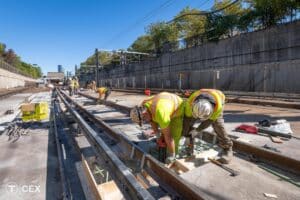
Repair workers replace track supports outside the MBTA Orange Line's Jackson Square station on Oct. 11, 2024. Photo courtesy of the MBTA
New data seems to suggest that the MBTA’s year-long campaign of subway maintenance shutdowns has worked.
According to real-time data tracked by watchdog group TransitMatters, the agency’s Red, Blue and Orange lines have been virtually free of slow zones this week, with only three detected on the Red Line, four on the Orange Line and none on the Blue Line. The MBTA’s own dashboard says these remaining slow zones have all been plaguing riders for over a year.
The T just completed repairs on the southern half of the Orange Line that saw tracks between Back Bay and the line’s terminus in Jamaica Plain shut down for nearly two weeks. The work repaired tracks that had been allowed to fall into disrepair over the last 20 years by a complex cocktail of funding shortages, bad leadership and political disinterest.
A similar, month-long shutdown on the long-suffering Braintree arm of the Red Line took place over the entire month of September and saw improvements that shaved as much as 24 minutes off travel times for commuters on the line, the MBTA said once the shutdown was over.
It’s a stark contrast to the 57 slow zones the MBTA said it had across its three heavy rail subway lines and its Green Line light rail network at the start of October and the 229 it had this time last year.
Slow zones have been T management’s historic response to deteriorated tracks that were no longer safe enough for trains to travel across at full speed. Current MBTA General Manager Phil Eng has made their elimination by Dec. 31 a top priority through a series of maintenance shutdowns on different parts of the subway system, some of which lasted multiple weeks following a scathing federal safety report issued under Eng’s predecessor criticized the MBTA’s lack of progress on repairing track in the slow zones. Some of those slow zones, like one on the Green Line’s C branch in Brookline, had lingered for years on end before the 2024 repair campaign.
“We are committed to giving the public what they expect and deserve: safe, reliable, and improved service. This Orange Line diversion allowed us to perform long-deferred infrastructure work, eliminating all the speed restrictions to provide a smoother ride with shorter travel time, giving people precious time back in their lives,” Eng said in a statement released Monday after the most recent Orange Line shutdown completed. “As we rebuild the T, I hope to restore public trust and confidence, making the MBTA the preferred choice of travel. Soon, the Orange Line will be completely free of slow zones. With only 1 percent of our system remaining with restrictions, we are on our way to fulfilling our promise to the public we serve, eliminating all the speed restrictions systemwide under this Track Improvement Program”
The remaining Orange Line slow zones – between Malden Center and Oak Grove on both the north- and southbound tracks, between Malden and Wellington on the northbound track and between Assembly Square and Sullivan Square on the southbound track – are expected to be eliminated during a pair of shutdowns scheduled to take place between Saturday, Oct. 26 and Friday, Nov. 1. The worst remaining Red Line slow zone, between Andrew Square and JFK/UMass on the line’s Braintree leg, is up for repair Nov. 5-10.
While the T says it’s used this year’s extensive shutdown campaign to do other types of deep maintenance on the system, from repairing station staircases to replacing track switches, transit experts say that shorter, partial line shutdowns will still have to be part of the MBTA subway network’s future to prevent a repeat of the maintenance debacle the T is currently recovering from.






